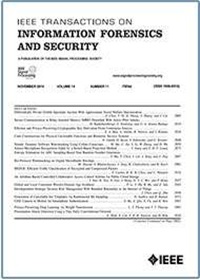Information-Theoretic Security Problem in Cluster Distributed Storage Systems: Regenerating Code Against Two General Types of Eavesdroppers
IF 6.3
1区 计算机科学
Q1 COMPUTER SCIENCE, THEORY & METHODS
IEEE Transactions on Information Forensics and Security
Pub Date : 2025-02-27
DOI:10.1109/TIFS.2025.3546567
引用次数: 0
Abstract
In recent years, there has been growing interest in heterogeneous distributed storage systems (DSSs), such as clustered DSSs, which are widely used in practice. However, research regarding information-theoretic security in heterogeneous DSSs remains limited. Furthermore, unlike traditional DSSs, the heterogeneous DSSs face eavesdropper with diverse operating patterns, complicating the secrecy models. In this paper, we aim to investigate the secrecy capacity and code constructions for clustered DSSs (CDSSs), a type of heterogeneous DSSs in which the system is divided into clusters with an equal number of nodes and different repair bandwidths for intra-cluster and cross-cluster against two types of eavesdroppers: the occupying-type eavesdropper and the osmotic-type eavesdropper. We construct two CDSS secrecy models tailored to these aforementioned eavesdroppers, derive the upper bounds on adjustable secrecy capacities, and explore the relationships between the upper bounds of perfect secrecy capacities and the number of compromised nodes. Notably, the upper bounds obtained in this paper generalize those of the traditional DSS model. Additionally, we propose three repair-by-transfer code constructions that achieve the secrecy capacity under both eavesdropper scenarios. These codes are based on nested MDS code and represent a generalized form of the minimum bandwidth regenerating (MBR) codes in traditional DSSs.求助全文
约1分钟内获得全文
求助全文
来源期刊

IEEE Transactions on Information Forensics and Security
工程技术-工程:电子与电气
CiteScore
14.40
自引率
7.40%
发文量
234
审稿时长
6.5 months
期刊介绍:
The IEEE Transactions on Information Forensics and Security covers the sciences, technologies, and applications relating to information forensics, information security, biometrics, surveillance and systems applications that incorporate these features
 求助内容:
求助内容: 应助结果提醒方式:
应助结果提醒方式:


